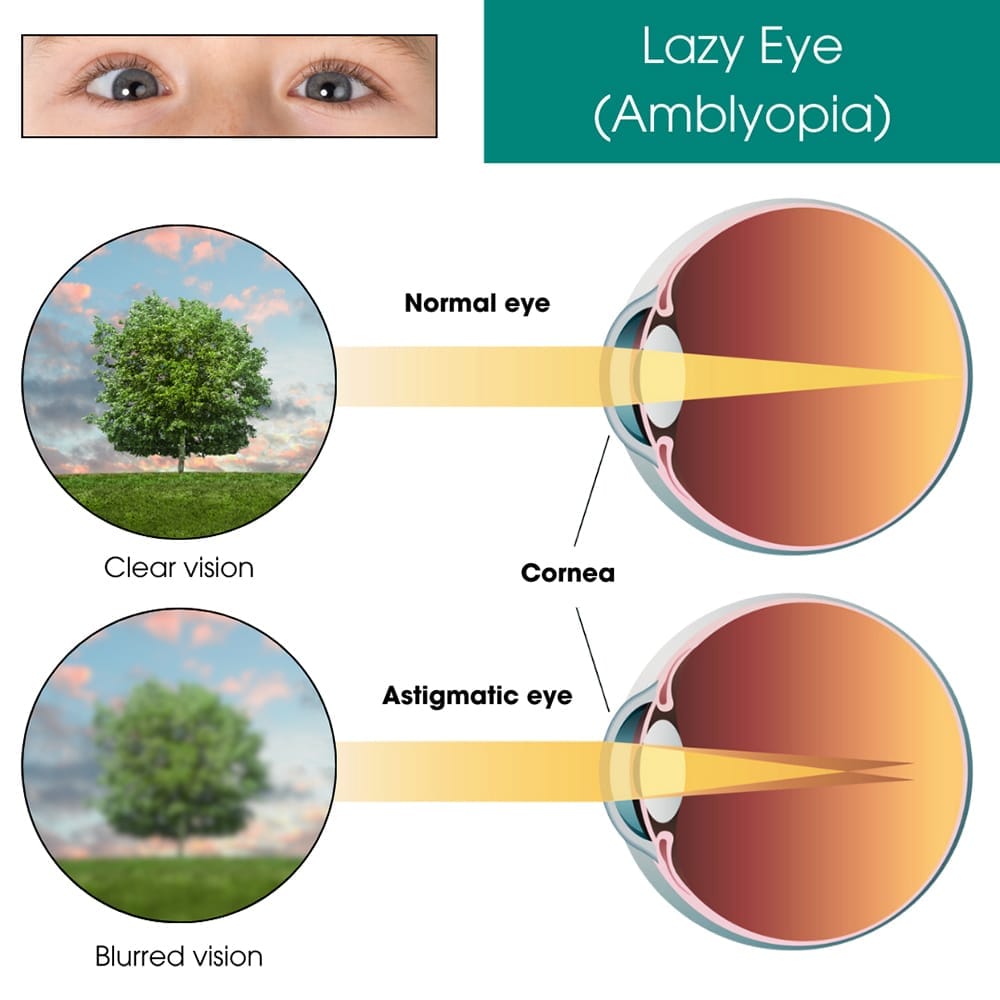Lazy eye, technically called amblyopia, is a vision impairment that typically affects the eyes of small children, although you may need a lazy eye test if you’re an adult as well. While in most cases one of the eyes is affected, there are instances when both are compromised. Untreated amblyopia is the leading cause for vision loss in children. It’s estimated that in every 100 children, two to three need amblyopia treatment.
Parents are urged to get comprehensive eye care for children as a preventive measure to catch the condition early on. Your Downtown Manhattan and NYC pediatric lazy eye doctor Optometrist may suggest the lazy eye test if the condition is suspected during the regular pediatric eye exam.
At the New York City based Eye Physicians, optometrists routinely check for anomalies like color blindness, (Color Vision Deficiency) amblyopia and myokymia in addition to common conditions such as:

Normally, the brain receives images from both eyes, which are then combined to give you the complete picture. In the lazy eye, a malfunction occurs during the development of the child or later in life following trauma or some other kind of eye disease. Vision in one eye usually is normal, while the other eye is weak. This makes it harder for the brain to interpret the images. In time, the brain relies solely on the stronger eye for the complete picture, ignoring images from the weaker eye.
Squinting, called strabismus, is a different eye condition that’s also marked by misaligned eyes. In amblyopia vs. strabismus, the brain ignores the images from the crooked or cross eye to avoid diplopia (double vision). This point is important in the discussion of amblyopia vs. strabismus as many assume both these eye conditions are the same. Strabismus causes strabismic amblyopia if not corrected, which is why it’s vital that you see an experienced lazy eye doctor to get the proper diagnosis and the best amblyopia treatment in Downtown Manhattan, NYC.
The type of amblyopia you have depends on the underlying eye condition, which could include:
Great Experience. Modern clean office. Was seen right away. Dr Hogue was very knowledgeable and friendly. I Highly recommend!
ReviewsWonderful experience…I was really worried about the eye tests..every step was explained and equipment clean .. from the receptionist to the doctor… a nice experience!
ReviewsDr cooney is the best eye doctor on the entire world!
ReviewsThe World Health Organization estimates that 12 million children younger than 15 have lost their vision due to unchecked refractive amblyopia. Children under the age of seven are at high risk as their vision is still under development. About 90 percent of amblyopia cases are because of strabismus or refractive errors that weren’t treated.
Additional risk factors associated with children include:
Additionally, developmental disabilities like Down Syndrome, DiGeorge Syndrome and Williams Syndrome also put you and your children at risk. Children with Noonan syndrome have a 32 percent chance of needing lazy eye treatment. In the nearly five percent of adults in the U.S. with a lazy eye, most are due to untreated medical conditions and eye damage.
Unlike strabismus where crooked eyes are noticeable, amblyopia isn’t noticeable. The only way you learn you have amblyopia is when you get an eye exam. Test But by then, it may be too late to get back your lost vision.
As there is no clear indication on the eyes for amblyopia, parents need to be extra vigilant to notice certain behaviors that hint at the need for how to fix a lazy eye, such as:
Read more: Pterygium (Surfer’s Eye) Removal
The mainstay for lazy eye treatment is correcting the underlying cause and to encourage the use of the weaker eye. The first treatment involves astigmatism correction involving corrective glasses or contact lenses. About 27 percent of refractive amblyopia cases are resolved using this method, while those with strabismus amblyopia show significant improvement in vision.
If the glasses don’t work, you may need other forms of lazy eye treatment such as:
It’s important to consult with an eye care professional to determine the most appropriate treatment plan for lazy eye based on individual needs and the underlying causes of the condition. Early intervention is key to maximizing the effectiveness of treatment.
Research also shows that video games and virtual reality devices motivate children and adults to practice eye exercises longer, which is a revolutionary breakthrough that brings hope to the two to four percent of Americans living with amblyopia. Contact Eye Physicians in NYC today to get you and your children a lazy eye test and all other types of eye tests that keep your vision healthy and working well.
Eye Physicians
110 Lafayette St, Suite 503
New York, NY 10013
(212) 292-4814
Entrust the care of your precious eyesight to highly skilled and experienced eye care professionals. For top-notch ophthalmologists and optometrists in Downtown Manhattan, choose Eye Physicians. Eye Physicians ensures prompt care, precise diagnosis, and personalized treatment plans.
Schedule an Appointment